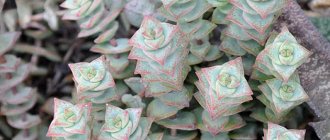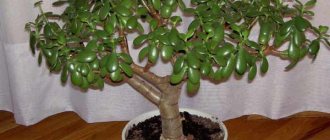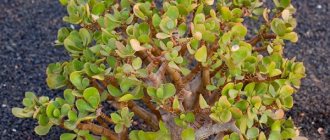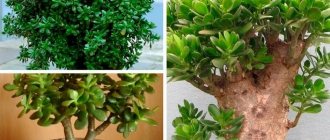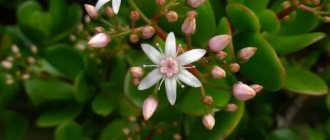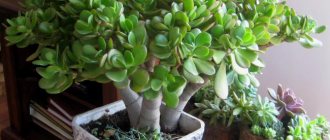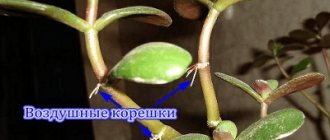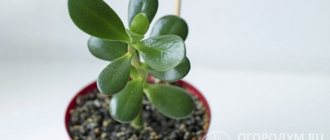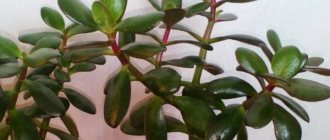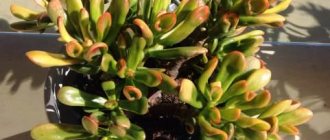Crassula is a succulent belonging to the Crassula family. But it is popularly known by other names.
A characteristic feature of the plant is its thick, fleshy leaves, for which it is nicknamed Crassula. Moisture accumulates in the leaves (they are placed crosswise), thanks to which the succulent easily tolerates prolonged droughts.
Most people know Crassula as the money tree. It is believed that the plant attracts wealth and prosperity into the home. This fact is confirmed by many gardeners who grow Crassula.
In order for the money tree to properly perform the function of a money magnet, it must be healthy and lush. If the bush is weak and stunted, then the inhabitants of the house will be haunted by failures and unplanned expenses.
Crassula also has a beneficial effect on the home atmosphere, charging it with positive energy.
If there is a negative atmosphere in the house, the inhabitants constantly argue, are stressed or get sick too often, then the plant will begin to dry out and soon die.
Another useful property of the plant is the ability to release substances into the air that destroy viruses, pathogenic viruses and fungi.
In folk medicine, Crassula juice is used to treat wounds, bruises, insect bites and skin diseases, as it is similar in effectiveness to aloe juice. But internal use is strictly contraindicated, since the composition contains arsenic.
Crassula flower: features of the genus of succulent culture
Crassula is a large genus of succulent plants found in many parts of the world, but the species used in horticulture or by collectors mostly originate in South Africa. The genus Crassula has an average of 300-500 species.
Photos of different types of Crassula
The external diversity of Crassulas is very great. Such succulents are found in the form of herbaceous or aquatic plants, they can be tree-like shrubs, miniature succulents. A common feature of most representatives of the genus is the placement of leaf blades on the shoot opposite each other. At home, Crassula are smaller in size than those that grow in nature. But over time, the crop becomes a miniature or medium-sized tree, which has a fairly thick stem.
The leaves have a simple, entire-edged shape; some species have ciliated leaf blades. Inflorescences can be lateral or terminal, the configuration is racemose or umbellate-paniculate. Flowers can consist of several shades - yellow, red, white, pale blue. But keep in mind the fact that indoor Crassula almost never blooms.
But their unpretentiousness, ease of care, and spectacular appearance have made these types of plants one of the most popular in decorating rooms.
Crassula or Crassula flower: care at home
Crassulas prefer a minimum of watering, regular washing of leaf plates and systematic feeding. Proper planting of crops is also of great importance. Pots that are too large will cause the root of the bush to begin to grow deeper and the trunk to develop upward. This will lead to weakening and thinning of the plant. Therefore, choose small and low pots.
Photo of Crassula marnieriana
Start preparing the correct soil mixture. It is formed on the basis of turf, leaf soil, as well as humus. Additionally add sand and brick chips. After the bush reaches 15 centimeters in height, pinch off 2 small leaf plates that are located at the top. At this point, the bush will begin to produce good branching - instead of 1 pair of leaves, two will form. The upper leaves are systematically broken off where branching is expected. This will give the Crassula the required shape.
Let us dwell on the main points that should be observed when caring for such beauties:
Lighting
The Crassula succulent tolerates sunlight well, so representatives of this kind can be safely placed on south-facing windows. But the optimal solution would still be to place the flowers on southwestern or eastern windows. If there is a lack of lighting, the leaves of crops will lose their decorative effect.
Ambient temperature
Crassulas are heat-loving plants. Therefore, summer is considered ideal and comfortable for the existence of succulents. But in winter it will be quite good even at temperatures of +10+15 degrees. These crops do not depend on air humidity; they grow equally, whether at low or high humidity.
Watering
The best option for watering Crassula is to use water as needed. When the top layer of soil dries, it means you can moisten the soil. In winter, you should wait until the substrate dries completely. The drying depth of the soil is 20-30 mm. It is not recommended to allow water to stagnate; it is better to let the substrate dry out.
Fertilizers
Crassulas prefer spring and summer feeding. They are usually performed once a month. The best option for such purposes would be fertilizer for cacti or succulents. In the fall and winter, you should stop applying all fertilizers.
Pruning and shaping Crassula
It is recommended to create a beautiful tree shape from a young age. Adult representatives may have stumps left in the places where pruning was done. This negatively affects the decorative appearance of crops.
Crassula transplant
It is recommended to replant succulents after the root system does not have enough space in the pot. This process is usually carried out once every 2-3 years. The optimal period is spring.
Crassula flower before planting in a new pot
Choose a new container larger than the old one, and be sure to form a drainage layer at the bottom. Expanded clay or crushed shards are perfect for this. After this, the flower is transplanted into a new pot, using the transshipment method. If the root system grows strongly in length, shorten the roots a little. Wanting the succulents to remain miniature, the Crassula indoor plant is not replanted at all.
Content
- 1 Description
- 2 Varieties 2.1 var. atropurpuria
- 2.2 var. anomaly
(Schonl. & Bak. F.) Toelken. - 2.3 var. Muirii
(Schönland) R. Fern.
(formerly rubella
(Compton) Token) - 2.4 var. cultriformis
(Fridr.) Token. - 2.5 var. Purcellii
(Shonl.) Token. - 2.6 var. Watermeyeri
(Compton) Token.
What are the methods of propagation of Crassula?
There are several options for propagating succulent crops of the Crasula genus. Let's look at the main methods.
Reproduction of Crassula by seeds
Crassula seeds are sown in wide bowls. They are filled with a soil substrate based on sheet soil and sand (1 to 2). The top of the container is covered with glass, and condensation is removed daily. Crops are also regularly ventilated. You can observe the appearance of the first shoots after 2 weeks. When the seedlings grow up, they are planted in a large container, with a distance of 10 millimeters between the bushes. The container is filled with a sand-turf mixture. When the picking is completed, the container with succulents is placed in a room with good lighting. When they grow up, each bush is placed in a separate pot. The air temperature at first should be +16-18 degrees Celsius.
Reproduction by cuttings
Cuttings allow you to get new Crassulas much faster than using the seed method. Castings and sections of stems are used as cuttings. A large leaf plate or shoot is trimmed using a sharp knife.
Photos of Crassula cuttings
The cut areas are treated with charcoal crumbs. The cuttings are withered for 2-3 days, after which they are planted in a substrate based on sand or leaf soil. After the roots appear, each cutting is planted in an individual container. For cultivation you will need leaf and turf soil, as well as sand (ratio - 1 to 1 to 1). After this, the bushes can be placed in a permanent location, and care is provided in the same way as for adult representatives.
Photo
Next you can see the photo of Crassula Portulakova:
The expert advice that you will find on the pages of our website will help you “make friends” with such types of Crassula as Perforata, Buddha Temple, Hobbit and Gollum, Tree-like, Ovata, Moss-moss, Sunset, Silver and Minor.
Crassula flower: pests and diseases
The biggest problem for Crassulas will be stagnation of water in the soil. This can cause root rot. Succulents can also suffer from drafts; in this case, the trees may dry out and the leaves may fall off.
Among the pests, the most popular are mealybugs. To eliminate them, you will need a cotton wool that is well moistened in an alcohol solution. Scale insects are also sometimes found. To combat them, treatment with Actellik is suitable. Fitoverm helps best against spider mites.
Signs about the Crassula flower, medicinal use of Crassula
Crassulas are frequent guests on the windowsills of apartments or offices. There is a sign that the “Money Tree” preserves the health of everyone who lives or is in the house. These plants are capable of releasing beneficial substances into the air. It is believed that they fight viruses, bacteria, and fungi.
Leaf juice is used in traditional medicine recipes. The solution helps to cope with bee stings, manifestations of herpes, and various bruises. The juice of the culture is also used as a rub to treat arthritis, as a rinse for sore throat, and gum inflammation. The juice should not be used internally as it contains arsenic.
Also, since ancient times, it is believed that the Crassula flower improves well-being and brings good luck in business.
Types of Crassula or Crassula
Let's look at the most popular plant varieties:
Crassula ovata
The most popular variety of Crassula among gardeners. Height in natural conditions is up to 3 meters. At home - up to one and a half meters.
Crassula ovoid or “Money tree” (commons.wikimedia.org)
The leaves are oval-shaped, have a glossy structure, and the color is green or grayish-silver. Umbrellas consist of white or pink flowers. It has high shade tolerance.
Crassula arborescens
Visually resembles the Crassula ovata variety. It has bare branches and a trunk; the leaf blades are flat but fleshy.
Crassula arborescens (wikimedia.org)
The color is pale blue, has a red border, up to 7 cm long. The inflorescences are panicle-shaped, have white or pink flowers. Does not grow in the shade, prefers only sunny areas.
Crassula lycopodioides
A shrub variety of Crassula, which has a fairly compact form. Height – no more than 25 centimeters.
Crassula lycophyte
The stems are fleshy and have curled tips. The species is undemanding in care and does well in light shade.
Crassula perforata
A small bush that is decorated with diamond-shaped leaves. The leaves are colored green, but with a bluish tint.
Crassula perforata
The edge has a red border.
Description
Crassula atropurpurea
in its habitat
This species is extremely variable. Usually it is a small (up to 60 cm) shrubby perennial with erect branched stems.
Its leaves are erect or slightly curled across the stem. The leaves are sessile, evenly arranged along the stems. Each leaf is usually linear-obovate (though this varies greatly) and has a slightly waxy surface. During drought or sun exposure, the leaves may turn purple.
Its slender, spike-shaped inflorescence bears pale yellow-white flowers.
The main distinguishing feature of this species is the rough canalicular dorsal petal process.[1]
